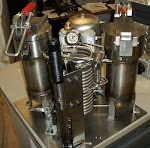“The Europeans have a more aggressive outlook toward alternative energy,” he said. This could trigger the phenomenon known Arbitrage. Basically if two or more security's are sold on different exchanges and one rises the other will also rise to create equilibrium between the two.
More Information on Arbitrage and why it can make an Investor a lot of money →
http://en.wikipedia.org/wiki/Arbitrage
Complete article below.
AlumiFuel delivers first of its hydrogen-making reactors
A company that has developed a proprietary method for making hydrogen from aluminum and water has delivered the first production models of a machine that generates the gas for use in weather balloons.
AlumiFuel Power Inc. recently delivered three of its PBIS-1000 Portable Balloon Inflation Systems to Kaymont Consolidated Industries Inc., a Huntington Station, N.Y., weather-balloon supplier.AlumiFuel, which is in the University City Science Center, expects Kaymont to buy more this quarter.
AlumiFuel is developing other applications for its technology, which produces super-heated steam as well as hydrogen. Those include flameless heaters for prepackaged meals, such as the ones troops eat, and propulsion systems for the Navy’s unmanned underwater vessels, or UUVs.
The technology won’t be able to produce hydrogen in large enough quantities for hydrogen-powered cars, should those become available, CEO David Cade said.
Methods for producing hydrogen from aluminum and water have been around for years, but AlumiFuel has developed proprietary additives that enable it to control the reaction, Cade said.
That, he said, enables it to develop applications tailored to specific tasks, such as generating lift gas for balloons that often are launched from remote areas.
“Nobody else in the world has developed a product like you will see here,” he said of the PBIS-1000.
Cade has a long history in the alternative-energy field. In the late 1990s and early 2000s, he was president and then CEO of Lithium Technology Corp., a Plymouth Meeting-based maker of lithium fuel cells. After that, he was president of the Americas for ABSL Power Solutions Ltd., an English maker of lithium-ion power systems.
AlumiFuel Power Inc. is a subsidiary of a publicly traded company based in Centennial, Colo., that it joined in a reverse merger last year. The publicly traded company used to be called Inhibiton Therapeutics Inc. but changed its name to AlumiFuel Power Corp. after the reverse merger.
Cade said AlumiFuel Power Corp. has formed another subsidiary, AlumiFuel Power International, which will enable it to be traded on the German Bourse and raise money from European investors.
“The Europeans have a more aggressive outlook toward alternative energy,” he said.
AlumiFuel’s growth plans also involve partnerships. Kaymont is its partner for lift-gas applications of its technology and Cade said it’s working with several defense contractors on applications for UUV propulsion systems.
AlumiFuel has two manufacturing partners for its portable balloon inflation systems: Apex Piping Systems Inc. of Newark, Del., which makes the machines; and ActionPak Inc. of Bristol, maker of the cartridges of powdered aluminum and AlumiFuel additives that, when mixed with water, enable the machines to produce hydrogen.
Additionally, AlumiFuel has Drexel University as a research partner. The company is a member of Drexel’s Materials and Nanotechnology Consortium and uses Drexel’s electron microscopes to analyze its material both before and after it reacts with water. It also is using a technology that Drexel is developing called in-situ microscopy that enables it to see its material through an electron microscope as it reacts with water.
“No one has done this for any sort of reaction,” said Sean McIntosh, AlumiFuel’s director of engineering.
The first market AlumiFuel is going after, lift gas, used to be dominated by helium, but a helium shortage has put hydrogen back on the map in the market, which AlumiFuel estimates at $70 million annually and growing.
AlumiFuel’s machine is transportable to remote locations. Users only have to supply it with cartridges, which look like 32-ounce cans, and any type of water available. Other hydrogen systems require users to transport large canisters of the gas to and from their launch sites.
The next application AlumiFuel is closest to having ready is its heaters. It has presented its product concept and test results to the Defense Department, and is working to become qualified as a subcontractor to the three companies that supply prepackaged meals to troops.




